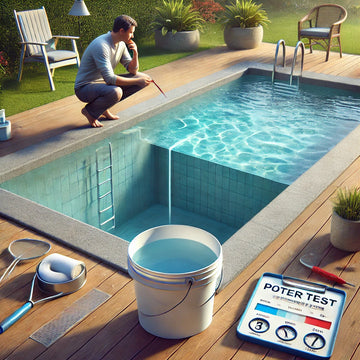POOL REMOVAL CONTRACTORS DISCUSS WHAT GOES INTO INGROUND POOL REMOVAL & DEMOLITION
Whether you’re over the maintenance of your pool or you have other plans for your backyard landscape —you have options!
You can hire the pros to take care of your inground pool maintenance for you. Or you can remove the pool.
Pool demolition experts can help you make the most of our backyard living space by removing or partially removing your inground pool to make way for bigger, better plans.
Here’s what’s in store for this type of pool renovation, how it works, some price-points, and the benefits of pool removal.
HOW IT’S DONE – FULL VS. HALF INGROUND POOL REMOVAL
Half/partial Inground pool removal usually involves:
- Draining the pool of any remaining water.
- Drilling holes in the bottom of the pool for additional drainage.
- Demolishing the top layer of the pool.
- Backfilling the pool with rubble—usually gravel and soil.
- Adding and compacting topsoil.
Full inground pool removal involves:
- Draining the pool of any remaining water.
- Pool demolition of all pool materials—not just the top layer. The pool materials are broken into pieces that are more easy to move/work with, and the pieces are removed from the property, loaded into a dumpster or trailer, and transported to a local landfill or recycling plant.
- Backfilling the hole with gravel and/or soil.
- Compacting and prepping the area for landscaping.
AVERAGE COSTS TO REMOVE/FILL INGROUND POOLS
The average cost to remove and fill a pool will depend on several factors, including:
- Type of pool material—e.g., vinyl, concrete, fiberglass, etc.
- Size of the pool
- Accessibility of the pool area
- Method of pool removal
The average cost to completely remove an inground pool ranges from $9,000 to $19,000. While the average cost to fill in a pool (partial removal) is around $5,000.
For a small- (10 feet by 20 feet) to medium-sized (15 feet by 30 feet) inground pool with fairly easy access, the average cost of removal is between $3,000 and $7,000. And for a larger, more complicated project—e.g., a large pool with a large deck and difficult access—the average cost will be $10,000 or more.
To figure out the cost to remove an inground concrete pool, or whichever type and size of pool you have, get an estimate from your local pool removal contractor.
REASONS TO REMOVE OR FILL YOUR INGROUND POOL
You are no longer able to or want to take care of your pool—pool maintenance is becoming too costly or demanding of a chore.
You don’t want the added safety hazards and liabilities of pool ownership—especially if you have small children or pets in the family.
Your pool is no longer being used.
You want to change your backyard landscape to suit your recreational or outdoor living space needs.
You want to replace your old pool with a new one.
ADVANTAGES OF FULL REMOVAL VS. PARTIAL REMOVAL
PROS OF PARTIAL REMOVAL
- Save time and money on pool maintenance.
- Eliminate the safety hazards and liabilities of pool ownership.
- Increase backyard space for landscaping and outdoor activities.
- Partial removal is an affordable option for inground pool removal.
- Partial removal is the fasted way to remove a pool.
PROS OF FULL REMOVAL
- Save time and money on pool maintenance.
- Eliminate the safety hazards and liabilities of pool ownership.
- Increase backyard space for landscaping and outdoor activities.
- Full removal should not impact the value of your home—but you will need to disclose this to potential homebuyers.
- Reduced/eliminated risk of sinking and seepage since there is no concrete buried in the old pool.
DISADVANTAGES OF FULL REMOVAL VS. PARTIAL REMOVAL
CONS OF PARTIAL REMOVAL
- You will no longer have a pool to swim in. If you love swimming and use your pool often, then the benefits of owning a pool will likely outweigh the costs.
- You will need to disclose the pool removal to future homebuyers—and it might affect the value of your home.
- Many municipalities consider the location of the filled-in pool as non-buildable, so you can’t build dwellings where your pool used to be. But the area can still be used for sheds, patios, concrete, trees, and landscaping.
CONS OF FULL REMOVAL
- You will no longer have a pool to swim in. If you love swimming and use your pool often, then the benefits of pool ownership might outweigh the costs.
- Many municipalities consider the location of the filled-in pool as non-buildable, so you can’t build dwellings where your pool used to be. But this area can still be used for sheds, patios, concrete, trees, and landscaping.
- Complete pool removal is a more expensive option than partial pool removal.
PERMITS TO CONSIDER
Depending on the regulations set by your local municipality, you might need to apply for a pool demolition permit before you can start your pool removal project.
Many municipalities have rules about pool removal, including how it must be removed. Some by-laws will require that a pool must be completely removed, while others may allow partial removal (filling in the pool). And if partial removal is allowed, there might be specific guidelines to follow on how to fill in the pool.
ALTERNATIVES TO POOL REMOVAL
If you no longer use your pool or want a pool, but you don’t want to remove it, here are some alternative uses for your pool:
- Ponds
- Garden space
- Sunken greenhouse
WHY YOU SHOULD HIRE THE PROS
Pool demolition and removal is a big job that requires the right equipment. And if not done properly, it can lead to costly problems for you and your property.
If the pool removal is not completed properly, there will be an increased risk of:
- The ground swelling;
- The ground sinking;
- A lack of proper drainage;
- Damage to driveways, septic tanks, sewer connections, surrounding landscaping, and other areas of your property.
A professional pool removal contractor will avoid this costly damage. They will assess the location and accessibility of the pool and know which type of equipment to use to complete the project carefully without damaging your property.
Professional pool removal contractors know what they’re doing. So instead of winging it and trying for a DIY project or hiring you handyman/brother, hire the pros. And get your pool removed or filled the right way so you can start enjoying the many new uses for your backyard space and landscape.




